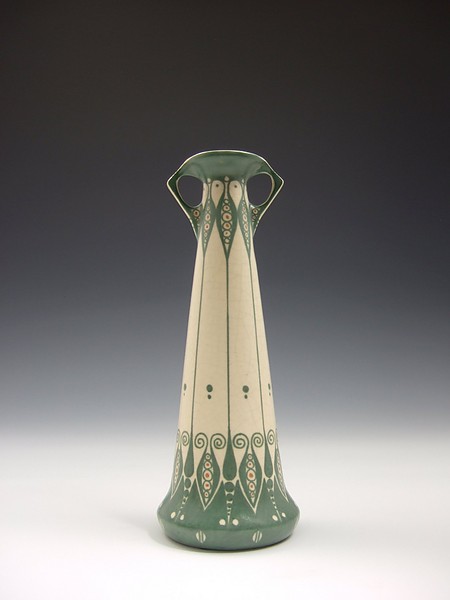Pottery factory “De Distel”
 Pottery factory “De Distel”
Pottery factory “De Distel”
Pottery factory “De Distel” was established by Jacobus M. Lob in Amsterdam in 1895, with the aim of producing decorative earthenware and tile panels. De Distel distinguished itself from other pottery factories by creating vases with a matte white glaze and the use of the ‘carduus’ technique, both of which were developed by the factory.
Initially, the decorations on the vases were made in the style of Rozenburg, a pottery factory situated in The Hague. The animal and plant motifs, inspired by Art Nouveau, were applied in dark colours and the vases were finished off with a shiny glaze. After taking over the tile factory Lotus in 1901, Bert Nienhuis became the artistic director of De Distel. His designs were inspired by Chinese and Japanese earthenware and the lavish patterns gave way to geometric decorations and strongly stylized animals and plants, applied on a white background and glazed with a matte white glaze.
Willem van Norden took over as the artistic director in 1911. He developed the ‘carduus’ technique, used on vases and tiles. Around 1914, De Distel also started cooperating with artists like Theodoor Colenbrander, Theo Nieuwenhuis and Carel Lion Cachet. Interest in decorative earthenware subsided after the First World War and De Distel was sold to Goedewaagen from Gouda in 1922.
Carduus technique
The ‘carduus’ technique is a decoration technique used on vases and tiles, developed at pottery factory De Distel in 1909. The technique is based on the Spanish/Moorisch cuerda seca technique, where lines where applied to the earthenware to prevent the different glazed sections from mixing.
Inspired by the cloisonné tiles, manufactured by pottery the Porceleyne Fles, Willem van Norden developed his own technique in 1909: the ‘carduus’ technique. Rather than separating the glazes by using clay, like the cloisonné tiles, Norden based his method on the cuerda seca technique, a Spanish/Moorish method which originated from an ancient Islamic way of decorating. This technique is characterized by the use of a mixture of manganese oxide and oil or wax, which was applied to the earthenware. The sections between these lines were then covered with glazes in different colours. The wax would melt in the firing, leaving only the manganese oxide in the shape of black lines.
Van Norden used a mold to press the abstract decorations in the biscuit (i.e. earthenware that was baked once). He then painted the lines black and covered the areas in between the lines with a thick, enamel-glaze paste. Theo Nieuwenhuis and Jac.van den Bosch often used this technique in their designs.
